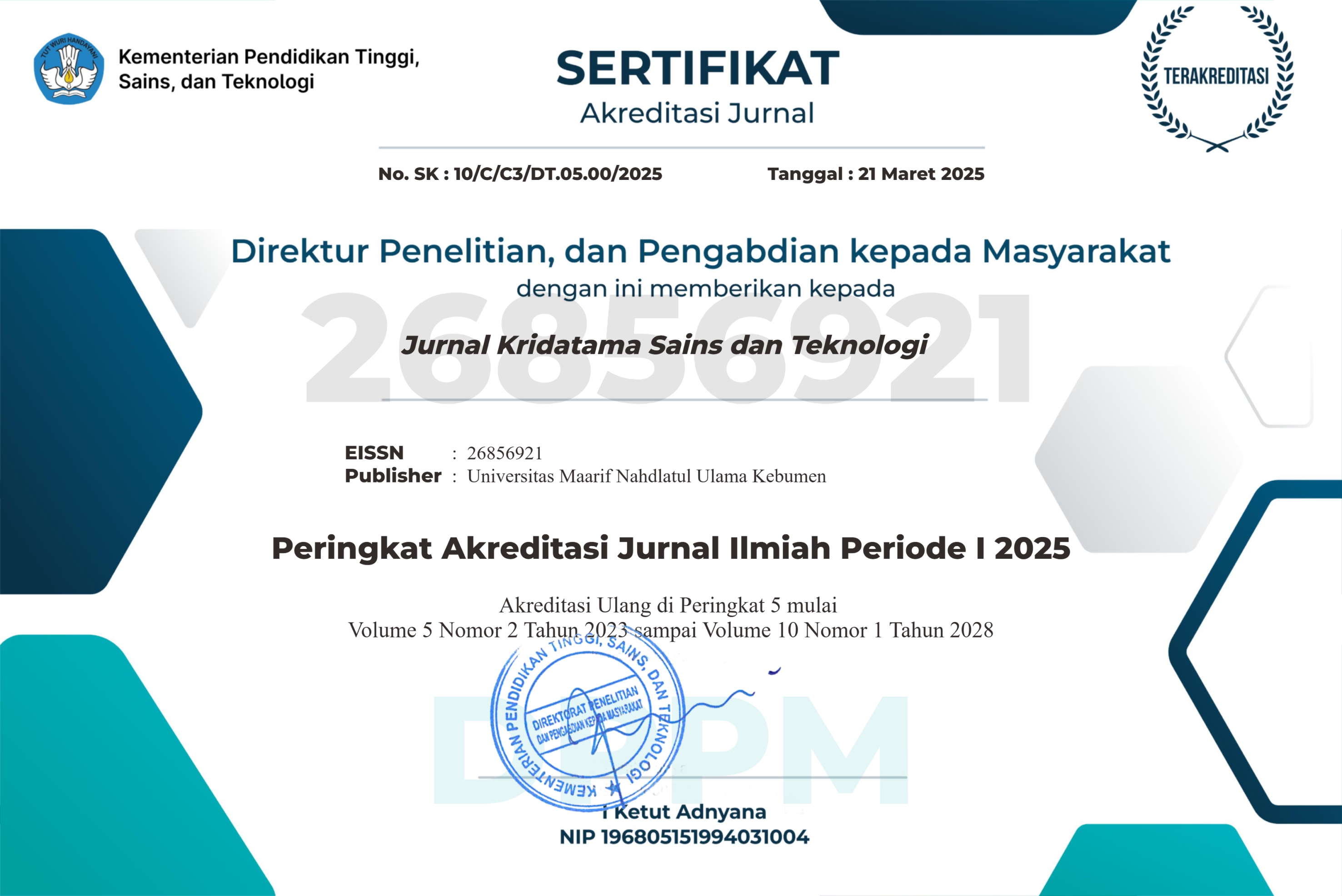Analisis Debit Aliran Sungai pada Kali Sadang Cibitung Kabupaten Bekasi
DOI:
https://doi.org/10.53863/kst.v7i01.1599Keywords:
discharge, flow, irrigation, nakayasu, riverAbstract
The Sadang River is a primary channel in Cibitung Subdistrict, Bekasi Regency, which functions to channel water from several secondary channels, including those in Wanajaya Village and Wanasari Village. The existing conditions show that the Sadang River is prone to overflowing during the rainy season and is unable to optimally support the irrigation needs of the surrounding agricultural land. Therefore, a redesign of the channel system is necessary, including increasing the river's storage capacity through channel dimension improvements based on peak flow rates derived from hydrological analysis, as well as integrated watershed management efforts. The objective of this study is to analyse the river flow discharge in the Sadang River, which is divided into four segments, and to address the river flow discharge. The research method used in this study is a quantitative method with a hydrological and hydraulic analysis approach. The hydrological analysis process was carried out by determining the average rainfall and analysing the flood discharge using the Nakayasu Synthetic Unit Hydrograph (HSS) method. Subsequently, measurements of the existing channel dimensions were taken, spatial analysis was conducted using ArcMap 10.8 software, and the channel dimensions were re-planned based on the planned peak discharge results. The research results show that the existing flow rate of the Sadang River is 954.37 m3/sec, and the analysis of the peak flow rate of the Sadang River with a 10-year return period is 6107.47 m3/sec and a 25-year return period is 7513.01 m3/sec, with the same peak time of 2 hours. It is necessary to plan with a rectangular channel, the dimensions of the channel base width (b) = 28.7m and channel height (h) = 10m because the river channel is unable to accommodate the flow of flood discharge.
References
Adzhani, M. D., & Tayubi, Y. R. (2019). Analisis curah hujan terhadap debit air sungai di daerah aliran sungai citarum. In Prosiding Seminar Nasional Fisika (Vol. 1, No. 1, pp. 459-461).
Alie, A. H., & Suharyanto, S. (2024). Akurasi Data Curah Hujan Satelit Terhadap Data Pengukuran di Daerah Tangkapan Air (DTA) Waduk Sutami: The Accuracy of Satellite Rainfall Data Compared to Measurements at Sutami Reservoir’s Catchment Area. Bentang: Jurnal Teoritis dan Terapan Bidang Rekayasa Sipil, 12(1), 75-82.
Ardana, P. D. H., Soriarta, K., Widnyana, I. G. A., & Diasa, I. W. (2021). Analisis Debit Banjir Rancangan di Daerah Aliran Sungai Tukad Mati Studi Kasus: Daerah Aliran Sungai Tukad Mati. Jurnal Teknik Gradien, 13(2), 58-70.
Arifin, Z., & Maulidiyah, A. (2025). Analisa Debit Banjir Rencana DAS Rejoso Menggunakan Metode Hidrograf Satuan Sintetik Nakayasu. Jurnal Komposit: Jurnal Ilmu-ilmu Teknik Sipil, 9(1), 17-26.
Bugis, R., Farida, A., & Pristianto, H. (2024). Pengaruh Geometri Sungai Terhadap Debit Aliran Studi Kasus Das Klasaman Kota Sorong. Jurnal Ilmiah Teknik Sipil (JIMATS), 3(02), 96-103.
Jayantari, M. W., & Eryan, I. G. A. P. (2024). Analisis Debit Banjir Rancangan Daerah Aliran Sungai Yeh Ho Dengan Metode Hss Nakayasu. Konferensi Nasional Teknik Sipil (KoNTekS), 2(5).
Kironoto, B. A., Yulistiyanto, B., & Olii, M. R. (2021). Erosi dan konservasi lahan. UGM PRESS.
Kumajas, A., Sumarauw, J. S., & Supit, C. J. (2024). Analisis Debit Banjir dan Tinggi Muka Air Sungai Sapalalum Di Desa Lelema Kabupaten Minahasa Selatan. TEKNO, 22(89), 1821-1833.
Nadia, K., Mananoma, T., & Tangkudung, H. (2019). Analisis debit banjir dan tinggi muka air Sungai Tembran di Kabupaten Minahasa Utara. Jurnal Sipil Statik, 7(6), 703-710.
Parhusip, Y. G., & Anggraheni, E. (2024). Influence of Erosion Potential Analysis Based on Land Use Change in Upper Citarum Watershed. Bentang: Jurnal Teoritis dan Terapan Bidang Rekayasa Sipil, 12(2), 153-160.
Putranto, D. D. A., Yuono, A. L., & Effendi, M. M. (2020). Analisis Profil Dasar Saluran Untuk Mengurangi Kecepatan Aliran Pada Pengalihan Sungai. Cantilever: Jurnal Penelitian dan Kajian Bidang Teknik Sipil, 9(1), 47-56.
Satrio, I. R. (2024). Penilaian Risiko Keamanan Bendungan Menggunakan Metode Andersen untuk Bendungan Haekrit: Risk Assessment Using Andersen Method on Haekrit Dam. Bentang: Jurnal Teoritis dan Terapan Bidang Rekayasa Sipil, 12(1), 13-22.
Sihotang, R. I. C. O., Hazmi, M. I. F. T. A. H., & Rahmawati, D. E. B. B. Y. (2019). Analisis Debit Banjir Rancangan Dengan Metode HSS Nakayasu. Jurnal Rekayasa Teknologi Nusa Putra, 7(01).
Sulhan, R. A., Efendi, M., & Hapsari, R. I. (2020). Analisis Debit Banjir pada Sungai Buntung di Kabupaten Sidoarjo. Jurnal Online Skripsi Manajemen Rekayasa Konstruksi (JOS-MRK), 1(3), 79-84.
Syarifah, N., Dewi, V. A. K., & Id'fi, G. (2024). Analisis Transformasi Hujan-Debit dengan Metode Hidrograf Satuan Sintetik untuk Penetapan Banjir Rancangan pada DAS Manggar Kecil. G-Tech: Jurnal Teknologi Terapan, 8(4), 2823-2832.
Yakan, A. F., & Alhadar, N. I. (2024). Perbandingan Delineasi DAS Menggunakan HEC-HMS 4.11 dan ArcGIS 10.8. Portal: Jurnal Teknik Sipil, 16(3), 92-97.
Downloads
Published
How to Cite
Issue
Section
License
Copyright (c) 2025 Fazrul Falah, Elma Yulius, Sri Nuryati, Ninik Paryati, Fajar Prihesnanto, Eko Darma, Anita Setyowati Srie Gunarti

This work is licensed under a Creative Commons Attribution-ShareAlike 4.0 International License.
Authors retain copyright and grant the journal right of first publication with the work simultaneously licensed under a Creative Commons Attribution-ShareAlike 4.0 International License that allows others to share the work with an acknowledgment of the work’s authorship and initial publication in this journal

















